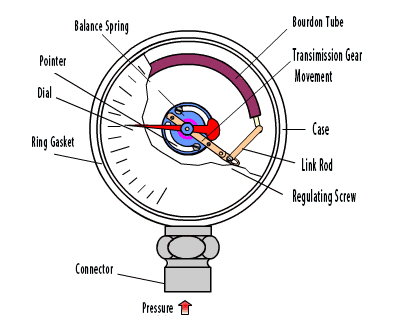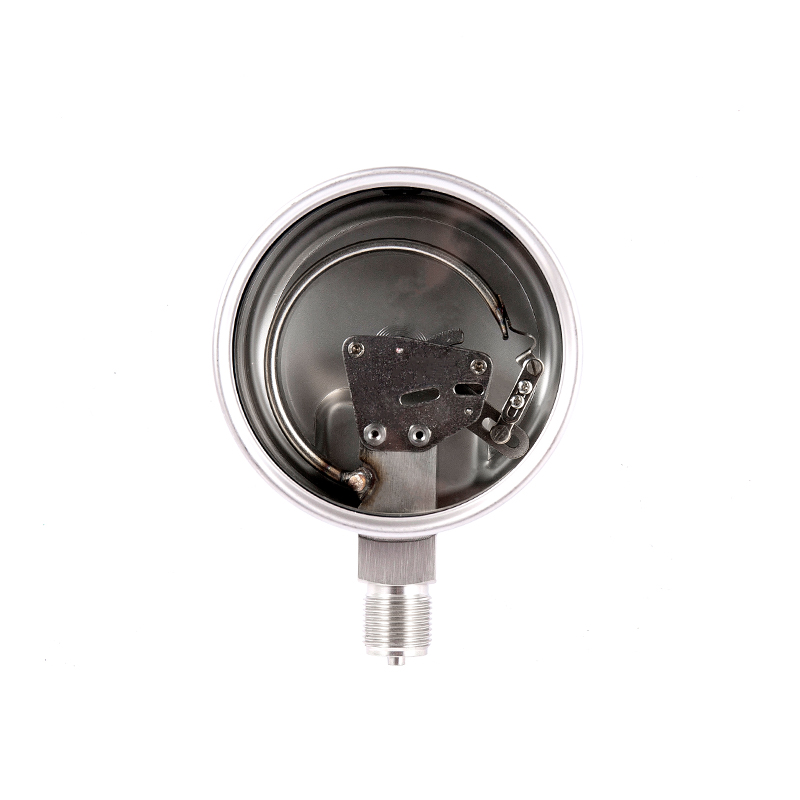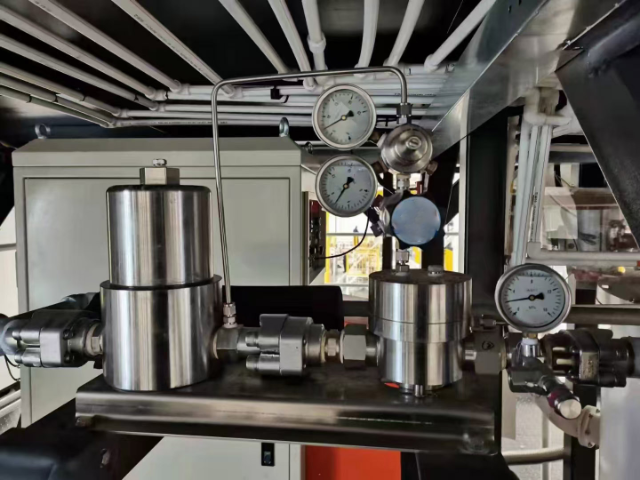YJY series absolute pressure gauge
Cat:Pressure Gauge
◆ Model: YJY100 YJY150◆ Use: Absolute pressure refers to the pressure which is higher than absolute ...
See Details
1. Main Structure of The Pressure Gauge
01 Elastic Sensitive Element
· Bourdon tube: The most common elastic element, it is in the form of a C-shape, spiral or helical shape, and is made of copper alloy or stainless steel. When the interior is under pressure, the Bourdon tube will extend outward, causing the pointer to rotate.
·Diaphragm:used for measurement low pressure and corrosivity meduim,Made of metal or rubber that will deform after being impacted by pressure.
·bellows:suitable for measuring very small pressures, with large deformation and high sensitivity.
02 Transimission Gear
·Link Rod:connect the elastic elements and the gear mechanism to transmit deformation displacement.
·Fan-shaped gear: Converts linear motion into rotational motion and amplifies the deflection angle of the pointer.
·Small gear: meshes with the sector gear and drives the pointer shaft to rotate.
03 Indicating Device
· Pointer: Displays the current pressure value and is usually used in conjunction with the dial.
·Dial: Indicates pressure units (MPa, bar, psi, etc.), and different measurement ranges correspond to different scale ranges.
04 Shell and Connecting Components
·Case: Protects the internal mechanism. The material is either plastic, stainless steel or aluminum alloy. Some shock-resistant pressure gauges are filled with oil (such as silicone oil or glycerin) inside to reduce vibration.
·Connection: It is used to connect the tested system. Common thread standards include G1/2, NPT, BSP, etc.
2. Working Principle of The Pressure Gauge

01 Propagation Of Pressure
·The measured medium (gas or liquid) enters the pressure gauge through the interface and acts on the elastic element (such as Bourdon tube, diaphragm or bellows).
02 Elastic Element Deformation
· Bourdon tube type: As the pressure increases, the Bourdon tube gradually straightens (in the case of a C-shaped tube) or expands (in the case of a spiral tube) due to the internal pressure, resulting in displacement.
· Diaphragm type: The pressure causes the center of the diaphragm to undergo bending deformation, and the displacement varies with the pressure.
· Bollows type: Axial expansion and contraction, suitable for measuring very small pressures.
03 Mechanical Transmission Amplification
The slight deformation of the elastic element is transmitted through the linkage mechanism to the sector gear, which then drives the small gear to rotate and cause the pointer to deflect. The function of the gear transmission mechanism system is to amplify the displacement, enabling the pointer to clearly indicate the pressure value.
04 Pointer Indication
The pointer moves on the dial and points to the corresponding pressure value. For example:
·When the pressure is 0, the pointer should point to the "0" mark (if not accurate, zero adjustment is required).
·When the pressure increases for muscle building, the pointer rotates clockwise, indicating the current pressure value.
05 Return-to-Zero Mechanism
When the pressure is released, the elastic element returns to its original state, and the pointer moves back to the zero position under the action of the hairspring (or spring).
3.Working Principle of Special Types of Pressure Gauges
01 Shock-Proof Pressure Gauge
·Internal oil filling (silicone oil or glycerin) to reduce the impact on the pointer during vibration
·Suitable for vibration environments such as hydraulic machinery and compressors
02 Differential Pressure Gauge
·Using a dual Bourdon tube or dual diaphragm structure, it measures the difference between two pressure sources.
·Used for filter monitoring, flow meters, and other related applications.
03 Digital Pressure Gauge
·Use pressure sensors (such as piezoresistive or capacitive) to convert pressure signals into electrical signals, which are then processed and displayed digitally.
·It can output 4-20mA or RS485 signals, which is suitable for automated control.
4.Summarize
·Mechanical pressure gauge: Based on the deformation of the elastic element combined with the rotation of the gear, it has a simple structure and is easy to maintain.
· Electronic pressure gauge: Sensor + digital display, high accuracy, capable of remote data transmission
·Selection criteria: Choose the appropriate type based on the medium, pressure range, and environment (vibration, corrosion).

Although the pressure gauge is small, it is of vital importance in industrial safety. Correct usage and maintenance can ensure long-term stable operation.